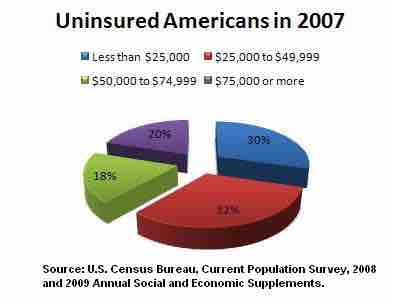Healthcare in the United States is provided by many separate legal entities. Healthcare facilities are largely owned and operated by the private sector. Health insurance is now primarily provided by the government in the public sector, with 60-65% of healthcare provision and spending coming from programs, such as Medicare, Medicaid, TRICARE, the Children's Health Insurance Program, and the Veterans Health Administration.
The United States is alone among developed nations with the notable absence of a universal healthcare system. Current estimates put U.S. healthcare spending at approximately 16% of GDP, second highest to East Timor (Timor-Leste) among all United Nations member nations. The U.S. system is primarily one of private insurance, with governmental insurance provided for citizens on the healthcare fringe. Insurance is provided by large-risk bearing corporate entities, which organize healthcare delivery by negotiating pricing and services with provider (physicians and hospitals) organizations. Most Americans under age 65 (59.3%) receive their health insurance coverage through an employer (which includes both private, as well as civilian public-sector employers) under group coverage, although this percentage is declining.
Debates about Healthcare in the United States
Active debate about healthcare reform in the United States concerns questions of a right to health care, access, fairness, efficiency, cost, choice, value, and quality. Some have argued that the system does not deliver equivalent value for the money spent. The United States pays twice as much, yet lags behind other wealthy nations in such measures as infant mortality and life expectancy. Currently, the United States has a higher infant mortality rate than most of the world's industrialized nations. Around 84.7% of Americans have some form of health insurance; either through their employer or the employer of their spouse or parent (59.3%), purchased individually (8.9%), or provided by government programs (27.8%; there is some overlap in these figures).
Furthermore, the number of persons without health insurance coverage in the United States is one of the primary concerns raised by advocates of healthcare reform. According to the United States Census Bureau, in 2009, there were 50.7 million people in the United States (16.7% of the population) who were without health insurance. Some Americans who do not qualify for government-provided health insurance are not provided health insurance by an employer, and are unable to afford, cannot qualify for, or choose not to purchase private health insurance. Many of the uninsured are the working poor or are unemployed. Although some are healthy and choose to go without it, others have been rejected by insurance companies and are considered "uninsurable. "

U.S. Uninsured in 2007, by income.
This image shows the income distribution of Americans who did not have health insurance coverage in 2007. The data comes from the U.S. Census Bureau's Current Population Survey in 2008 and the 2009 Annual Social and Economic Supplements–-available here (page 21).